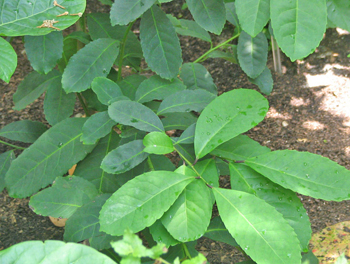Contents:
Common Names | Parts Usually Used | Plant(s) & Culture | Where Found | Medicinal Properties | Biochemical Information
Legends, Myths and Stories | Uses | Formulas or Dosages | Nutrient Content | Bibliography
Scientific Names

- Ilex paraguariensis L.
- Holly family
Common Names
- Holly
- Matè
- Paraguay tea
- Yerba
Parts Usually Used
All parts
Back to Top
Description of Plant(s) and Culture
Yerba Matè is an evergreen shrub or small tree up to 20 feet high; its alternate, elliptic-obovate leaves have a narrowed base and a rounded or bluntly pointed tip; their margins are crenate-serrate. The axillary flowers are whitish and inconspicuous. The fruit is a rounded, reddish berry-like drupe up to 1/4 inch in diameter.
Back to Top
Where Found
Grows in southern Brazil, Paraguay, and Argentina. It grows wild in the river forests; it is also extensively cultivated in other areas of South America.
Back to Top
Medicinal Properties
Depurative, diuretic, stimulant
Back to Top
Biochemical Information
Chlorophyll, iron, trace minerals, calcium, potassium, sodium, magnesium,
and vitamins B5, C, and E
Back to Top
Legends, Myths and Stories
Mate (pronounced mah-tay), the tea made from the plant, is the South American equivalent to coffee in the United States. Charles Darwin called it “the ideal stimulant”. It is estimated that the South American inhabitants consume approximately 8 million pounds of yerba mate each year. The herb is exported to the United States and other countries.
The tea as a beverage effects a surprising rejuvenation of the human organism. One drinking it, especially for the first time, feels a remarkable inflow of strength, energy, and cheerfulness, as a direct and almost immediate result.
The early Jesuit missionaries learned the use of this herb from the South American Indians and found the brew so refreshing and healthful that they risked their lives searching for the small trees in the dense jungles of Brazil. Later they brought the tree under cultivation near their missions and mate` became widely known as “Jesuit’s tea” or “missionaries tea”. It is said that the Jesuits added the word yerba (herb) to the Indian name mate`, which comes from a word meaning “drinking vessel” or “gourd”.
In the book The Magic of Herbs in Daily Living by Richard Lucas, there is a story about a 75 year old widower, living with his son and his family, was slipping mentally. Grandpa could not remember their names; it was necessary to lead him to the bathroom, he couldn’t find it by himself.
One day the son came across an article on yerba mate and immediately bought a pound of the herb. Grandpa liked the tea, and a month later, having taken the tea in the meantime, the son heard grandpa get up early one morning. To the son’s amazement, grandpa, all by himself, was just coming out of the bathroom. He shamed his son for staying in bed so late and stated that he guessed he would have to make his own tea that morning.
The family supplemented grandpa’s diet with dolomite pills (2 tablets 3 times a day) plus lecithin and wheat germ oil. Three months later grandpa’s memory was dramatically improved. He could easily remember all the names of his relatives and friends, and even that of the neighbor down the block. He was cheerful, energetic, and took an active and lively interest in the world around him.
Back to Top
Uses
For arthritis, headache, migraine, neuralgia, insomnia, hemorrhoids, fluid retention, obesity, fatigue, stress, constipation, allergies, and hay fever. Cleanses the blood, tones the nervous system, retards aging, stimulates the mental and physical energy, an excellent blood purifier, controls the appetite, stimulate production of cortisone, and is believed to enhance the healing powers of other herbs.
Its stimulant principle is caffeine, but it contains less than coffee or regular tea. Mate` may be the answer for the coffee addict who wants to get rid of his coffee nerves without breaking the habit.
Back to Top
Formulas or Dosages
To relieve constipation and allergy symptoms: use 2-3 tbsp. yerba mate` in 16 oz. hot water. Consume on an empty stomach.
Tea: use 1 tsp. to 1 cup boiling water. Honey or lemon may be added to taste. When iced, it makes a refreshing summer drink.
Back to Top
Nutrient Content
Chlorophyll, iron, trace minerals, calcium, potassium, sodium, magnesium, and vitamins B5, C, and E (rich in vitamin C)
Back to Top
Bibliography
![]() The Herb Book
The Herb Book, by John Lust, Bantam Books, 666 Fifth Avenue, New York, NY. copyright 1974.
![]() Prescription for Nutritional Healing, Fifth Edition: A Practical A-to-Z Reference to Drug-Free Remedies Using Vitamins, Minerals, Herbs & Food Supplements
Prescription for Nutritional Healing, Fifth Edition: A Practical A-to-Z Reference to Drug-Free Remedies Using Vitamins, Minerals, Herbs & Food Supplements, by James F. Balch, M.D. and Phyllis A. Balch, C.N.C., Avery Publishing Group, Inc., Garden City Park, NY
![]() The Yoga of Herbs: An Ayurvedic Guide to Herbal Medicine
The Yoga of Herbs: An Ayurvedic Guide to Herbal Medicine, by Dr. David Frawley & Dr. Vasant Lad, Lotus Press, Twin Lakes, Wisconsin, Second edition, 1988.
 The Magic of Herbs in Daily Living
The Magic of Herbs in Daily Living, by Richard Lucas, Parker Publishing Co. (1988).
